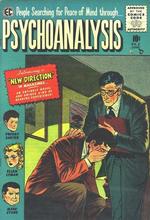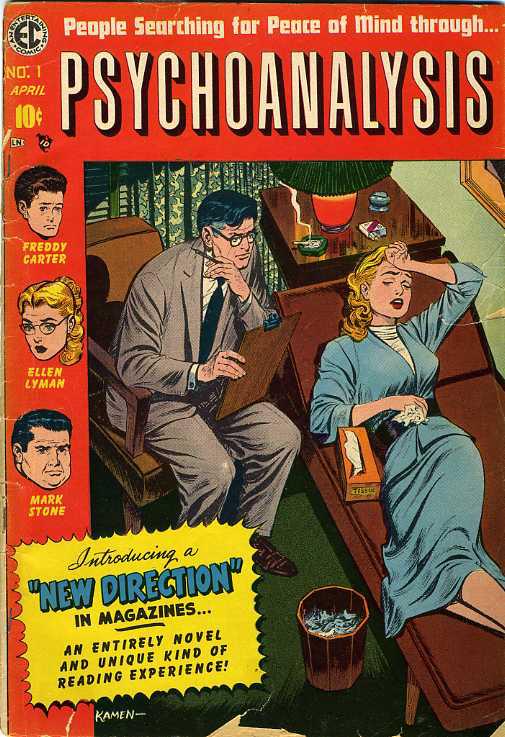
Throughout his lifetime, Sigmund Freud was far better known and respected abroad than he was in Vienna, where he lived and practiced for most of his years.
This first issue of “Psychoanalysis” was published by E.C. Comics in 1955. I found this cover posted on the Facebook page of the International Psychoanalytical Association (IPA), with the explanation:
The comic featured three patients, Freddy Carter, Ellen Lyman and Mark Stone who were undergoing psychoanalysis. The analyst was the central character and only referred to as ‘The Psychiatrist.’ According to the editors, “This magazine is our most difficult and revolutionary creative effort thus far. Through the medium of the comic format, we will attempt to portray, graphically and dramatically, the manner in which people find peace of mind through the science of psychoanalysis.” The comic was approved by the Comics Code Authority but newsstands did not want to display it and the publication only lasted for a total of four issues.
The entry on the comic in Wikipedia notes that at the invitation of Steve Allen, the first host of NBC’s Tonight show, “Psychoanalysis” was adapted and put on air in two dramatic episodes. That I would have loved to see; too bad it was pre-You Tube.
Here’s a link to the rest of the covers, all equally lurid. I can’t decide which is my favorite. You?
Stay tuned for more in this series about Freud and psychoanalysis in the popular imagination. I welcome all interesting Freud spottings.


What an odd idea for a “comic” book. And the name is so literal– for the reading public (of comic books) maybe even hard to decipher. I wonder if it would have done better with the name “The Shrink.” But I don’t know when that slang term came into being. Or “Tales from the Couch.”
I think the odd juxtaposition is one reason I thought of “Psychoanalysis” as an early graphic novel, though I suppose comics were in a fledgling stage and taken somewhat seriously. I guess many people were confused by the genre, since only four issues were published.
Everything seems so much more fun in comic book form. 😉
I think the cover of Issue #3 (the one with all the eyeballs) is my favorite. I’m not sure what that says… quick, someone analyze me!
I got a kick out of #3 too. It’s definitely the most surreal cover –though Freud didn’t like surrealism. Of course, he didn’t like America much either and these comics probably would have confirmed his dislike.
My thought exactly—a precursor to the graphic novel. Funny, I wonder why no one is “on the couch” in Mad Men. Maybe that’s why there was so much drinking and smoking in the post-war era—a way of managing the anxiety around all that repression.
That’s an excellent point, Deborah. You’d think at least one character in Mad Men would have seen a shrink before taking LSD, say, like Roger. Peggy, with her mother issues, would have been a perfect candidate — and that Jewish copywriter (whose name I can’t recall) would have a lot to say about his father.
Actually, it happened in the very first season! This is from the Wikipedia entry on Mad Men, Season 1:
Betty begins seeing a psychiatrist after her numb and shaking hands cause her to crash the family car. Don, initially resistant to the idea of psychotherapy, allows Betty to seek help. Behind Betty’s back, Don has Betty’s doctor report back to Don what Betty says in treatment.
I’ve wondered whether the creators of the show saw the EC Comic cover above. In the episode Betty lies on a chaise longue that looks like the one in the illustration, and even wears on an outfit similar to it!
Thanks for coming by and pointing this out! Great catch.
Alison Bechdel is hilarious. I am sure that graphic novel is worth a read.
It’s very interesting than an era I’ve always viewed as so conservative was so open to psychoanalysis, though I am not surprised there were only four issues of this magazine. It strikes me as something one would have to ask for over the counter.
I hadn’t heard of Alison Bechdel before; I’ll have to check her out. The reviews sounded very interesting. You’re right, though the 1950s seem suited for a massive dose of psychoanalysis, you wouldn’t think people would be able to acknowledge that publicly, would you?
Wait–there was one character in Madmen who saw a shrink–Betty. Remember, the shrink was actually confering with her husband behind her back (as I remember–I may have part wrong).
You’re right, Lydia — and there’s more: Here’s an article devoted to psychoanalysis and Mad Men: http://www.huffingtonpost.com/dr-prudence-l-gourguechon/madgirl-a-very-angry-chil_b_697127.html
Fascinating link. I wonder if the writer is serious or tongue-in-cheek when she remarks that Freud’s nephew was a lobbyist for bacon?
I wondered that too. Since it ties in with the meat section of this blog, that’ll have to be another topic for research.
I love how Ellen’s head shot features her wearing glasses but when she’s on the couch, the glasses are off and she is lying in a suggestive pose. No, not sexual at all….I like Lydia’s suggestion of the comic being named “Tales From The Couch”
Maybe because it’s in comic form, but the shrink reminds me of Clark Kent, mild mannered but just waiting to become Super Shrink (or, as you suggest, Super Lover). I agree, Tales from the Couch would be a good title.